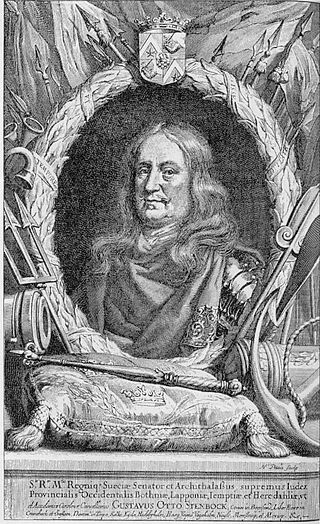

The House of Bonde is along with the houses of Bielke and Natt och Dag, one of the oldest surviving Swedish noble families. [1] The earliest attested nobleman who is known to have carried the name Bonde was Torer Bonde, who served as witness during the confirmation of a donation to the abbey at Vreta in either 1282 or 1286.
However, the most conclusively proven ancestors of the house were the brothers Tord Bonde (Petersson) and Erengisle Petersson (Bonde), who lived in the early 1300s. [1] Tord is attested to have been made a squire in 1310, then a knight in 1316 after which he joined the rebellion to oust King Birger Magnusson from the throne. Tord was among the delegates sent to sue for peace with Birger once he fled to the court of his brother-in-law King Eric VI of Denmark. He was also present at the council of lords who sentenced the former king's son Magnus Birgersson (not to be confused with the Swedish king Magnus Birgersson) to death. [2]
His brother Erengisle had a far less eventful life, the only thing that is known is that he was made squire in the year 1319 and remained as such until his death in 1350, and that the inheritance from him and his wife were split equally between his four children; the brothers Ragvald, Peter and Filip and their sister Ingeborg. [3]
Today, two branches of the family survive, both stem from the descendants of Erengisle. [1] The barons of the House of Bonde which is number 20 in the Swedish House of Nobility and the counts of the House of Bonde af Björnö, number 41.
Prominent members, bearing the name, include:
- Tord Bonde (c. 1350s–1417), medieval Swedish magnate
- Charles VIII of Sweden (Karl Knutsson Bonde) ; 1408/1409–1470), King, Charles I of Norway
- Magdalena of Sweden (1445–1495), Princess
- Gustaf Bonde (1620–1667), Swedish statesman
- Wilhelmina Bonde (1817–1899), Swedish courtier
- Carl Bonde (1872–1957), Swedish Army officer, equerry
- Carl C:son Bonde (1897–1990), Swedish Army officer
- Thord Bonde (1900–1969), Swedish Army officer
- Gustaf Bonde (1911–1977), Swedish diplomat





